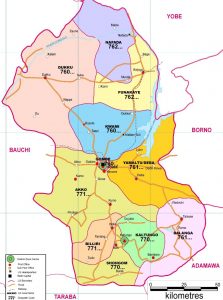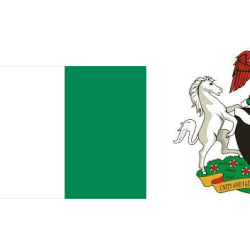The market days in Balanga Local Government Area of Gombe State are:
- MONDAY: Bambam
- TUESDAY: Balanga
- WEDNESDAY:Degro, D/Waja & Cham
- THURSDAY: Jessu, Nyuwar, Kulani & Gelengu
- FRIDAY: Talasse, Kwarge Bassa
- SATURDAY: Sikam, Kuture
- SUNDAY: Bangu
Balanga
Balanga is a Balanga Local Government Area in Gombe state, Northeast geopolitical zone of Nigeria.
Balanga LGA headquarters is Tallase.
The LGA shares borders with Adamawa state.
The towns and villages that make up Balanga are Bambam, Balanga, Tallase, Nyuwar, Kulani, Gelengu, Kwarge Bassa, and Bangu.
The vast majority of the people are of the Hausa and Waja tribes with their languages spoken extensively in the area.
Popular festivals are held in the area such as the Dadiya cultural festival and the Balanga Bird festival.
| Communities | Bambam Bangu Dadiya Degri Kulani Talasse |
| Headquarters | TALASSE |
| GPS Coordinates | N09058’23.0’’ E011040’10.0’’ |
| Post Code | 761002 |
| Area | 1,626 km² |
| Major Tribe | Waja and Dadiya |
| Other Tribes | Fulani, Hausa, Kanuri, Lunguda, Tangale, and Cham |
| Major Crops Produced | Maize, Millet ,beans and sorghum |
| Major Livestock Produced | Cattle and poultry |
| Major Attraction | Cham Valley Grass Land |
| Other Attractions | Balanga Dam, Mgua Tourist Pack, Dadiya Hills, Dele Hills, Gelengu Quarry, Swarandi Hills, Zwale Hill |
| Core Mineral |  Granite Granite |
| Comparative Vantage Products | Bentonitic clay ⋅ Cane Sugar ⋅ Cotton ⋅ Fish ⋅ Gemstone ⋅ Granite ⋅ Groundnut ⋅ Gypsum ⋅ Limestone ⋅ Livestock ⋅ Poultry ⋅ Sorghum ⋅ Trona ⋅ Wheat Potassium Granite Kaolin Columbite |
Approximate distance of communities, LGA and State headquarters
| Community | Distance from LGA Headquarters | Distance from State Headquarters |
| BAMBAM | 34.58KM | 77.25km |
| BANGU | 8.03KM | 73.72km |
| DADIYA | 54.72KM | 79.18km |
| DEGRI | 13.2KM | 74.72km |
| KULANI | 17.41KM | 72.96km |
| TALASE | 65.50KM- ‐ GM | 65.50KM |
GEOGRAPHY
Balanga LGA covers a total area of 1626 square kilometres with the average temperature of the area put at 35 degrees centigrade. The average humidity of Balanga LGA is at 17 percent while wind speed in the area averages 4 km/h.
ECONOMY
Agriculture is the economic mainstay of the people of Balanga LGA with crops such as tomatoes, Sorghum, maize, beans, and groundnut grown in the area. Balanga LGA has a number of mineral deposits such as Bentonite, limestone, granite, and topaz. Balanga LGA is also home to the economically important Balanga Dam.
Raw Materials
- Tomatoes
- Sorghum
- Maize
- Millet
- Beans
- Groundnut
- Cotton
- Livestock
- Fishery
- Gum Arabic
- Bentonite
- Limestone
- Tourmaline
- Topaz
- Bog Iron
- Calcite
- Basalt
- Agate
- Amethyst
- Mica
- Granite
- Tale
- Coal
- Vermiculite
Gombe
Gombe is one of the 36 states of Nigeria. It is located in the north eastern part of the country.
The state was created out of Bauchi state on 1st October 1996 by Sani Abacha’s administration.


Its creation was a fulfilment of the aspiration of the people who for long, had passionately craved for a state of their own out of the then Bauchi state.




Gombe State has eleven Local Government Areas (LGA) namely, Akko, Balanga, Billiri, Dukku, Funakaye, Gombe, Kaltungo, Kwami, Nafada, Shongom, and Yamaltu Deba.
The following are administrative maps of Gombe State showing the local government areas


Historically, Gombe state is a fusion of two distinct groups of people, comprising the people of Gombe North and the ethnic grouping of Gombe South.
Gombe is located on latitude 9”30’ and 12”30’N, Longitude 8”5’and 11”45’E.
It has borders with Borno, Yobe, Adamawa, Taraba, and Bauchi states.
The State climate is generally warm, with temperatures not exceeding 300c during the months of March-May considered to be the hottest months. The following table gives other profile of the jewel state.
The Emirate government, which had its Head quarters in Gombe Abba, was formed to effectively control what constitutes a larger part of the Gombe State, until the advent of the British in the early 20th century.
Under the British, the state was administered through the mechanism of two administrative units, i.e. Gombe Native Authority and Tangale Waja Native Authorities. The two Authorities constituted Gombe Division during the Colonial era. However, with independence in 1960 and the subsequent military administration, many changes occurred which led to the emergence of local government authorities. Thus, between 1976 and the present, the then two authorities had metamorphosed into the present 11 local governments.
Capital: Gombe
Land area: The State occupies a total land area of about 20,265sqkm.
Climate: Warm, exceeding 40″c during the hottest month (March – May)
Topography: Mainly mountainous, undulating and Hilly to the South-East and flat open plains in the Central, North, North-East, West and North-West.
Location: Latitude 9”30’ and 12”30’N, Longitude 8”5’and 11”45’E. The state lies in the centre of North east Geopolitical Zone of Nigeria. It shares common boundaries with Adamawa and Taraba State to the South, Bauchi State to the West, Borno State to the East and Yobe State to the North.

Power: The State is served by the PHCN National grid through the North-East PHCN substation located in Gombe State capital
Roads: Five(5) Federal trunk “A” roads connect the State Capital with all parts of the Country. Twonship roads have been constructed in the State capital and all the major towns.
Airport: The State has an International Airport which is also surrounded by four (4) International Airport, located in Kano, Jos, Yola and Maiduguri.
Major towns :Gombe the capital, Bajoga, Billiri, Kaltungo, Kumo, Dukku and Deba.
Ethnic CompositionMulti-ethnic, mainly made up of Fulani, Tangale, Waja, Bolawa, Tera,Jukun, Jara, Pero, Tula, Cham, Lunguda, Dadiya, Kamo, Awak, Kanuri, Hausa, Yoruba and Igbo.
Language spoken: English is the official language, but as much as Hausa remain the commercial language amongst the people of the state, Fulfulde, Tangale, Tera, Waja, and Kanuri are commonly spoken.
Vegetation: Gombe is generally a Guinea Savannah grassland with concentration of wood lands in the South East and South West.
Rainfall: Annual Average of 850mm.








